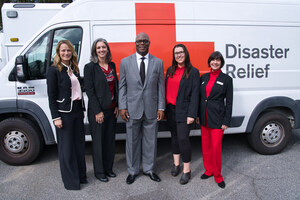WASHINGTON, July 9, 2018 /PRNewswire-USNewswire/ -- The American Red Cross issued an urgent call today for eligible individuals of all blood types to give now and help save patient lives following a difficult Fourth of July week for blood donations. Type O in particular is critically needed right now to replenish the blood supply.
Fewer blood donors and fewer blood drives during the Independence Day holiday week have escalated the Red Cross call for blood and platelet donors to help ensure hospital needs are met. More than 550 fewer blood drives were held the week of July 4 than an average week as people across the country enjoy vacations. In addition, AAA reported that a record 46.9 million Americans were expected to take trips to destinations 50 miles from home during the holiday period of Tuesday, July 3, through Sunday, July 8, potentially making donors less available to give during the week.
"Blood donations are currently being distributed to hospitals faster than donations are coming in – we need both new and current blood donors to make an appointment as soon as possible to help patients battling illness and injury," said Chris Hrouda, president of Red Cross Blood Services. "Unlike many other lifesaving medical treatments, blood donations cannot be manufactured and stockpiled. Red blood cells have a shelf-life of only 42 days and platelets just five days – Each donation, each day makes a difference."
It is crucial that the Red Cross has sufficient blood supply on hand to meet the needs of patients every day and to be prepared for emergencies that require significant volumes of blood. The summer season is traditionally a difficult time to collect enough blood to meet patient needs as high schools and college blood drives account for as much as 20 percent of donations during the school year.
Help ensure patients like Jacqueline receive lifesaving blood
Every day, blood and platelets are needed for accident and burn victims, heart surgery and organ transplant patients, and those receiving treatment for leukemia, cancer or sickle cell disease.
Patients like Jacqueline Rogers depend on the generosity of committed blood donors. When Jaqueline was born, she was diagnosed with complex congenital heart disease and by the age of nine she needed a second open heart surgery. On the way to the surgical floor, her family was told the operation would have to be delayed due to lack of available blood products.
"Something was wrong – there wasn't enough O negative blood. They said you can't have surgery," said Jacqueline. "I thought I was going to die."
For a child in need of lifesaving blood, such news can be scary and confusing. Thankfully, Jacqueline was able to have her much-needed surgery in the days following, but she and her family will always remember that day when the blood needed was missing from hospital shelves.
On June 11, the Red Cross launched the Missing Types campaign, which runs throughout the summer, to encourage new donors, and those who have not given recently, to donate blood. As part of the campaign, the letters A, B, and O – letters used to identify blood types – disappeared from corporate logos, favorite brands, social media and frequently visited websites to illustrate the critical role every blood donor plays. Many may not realize just how important the letters are, but for a hospital patient who needs type A, B or O blood, those letters mean life.
While the campaign helped to activate thousands of new donors in June to give—at this time, the Red Cross is calling on all eligible blood and platelet donors to roll up a sleeve as soon as possible.
Schedule an appointment to donate today
Eligible individuals are urged to schedule a blood or platelet donation today by using the free Red Cross Blood Donor App, visiting RedCrossBlood.org or calling 1-800-REDCROSS (1-800-733-2767). Donors can help even more people by inviting a family member, friend or co-worker to donate too.
The Red Cross encourages individuals to make a donation appointment and to complete a RapidPass online health history questionnaire to help speed up the donation process. RapidPass can now be completed on mobile devices and through the Red Cross Blood Donor App.
Individuals who are 17 years of age in most states (16 with parental consent where allowed by state law), weigh at least 110 pounds and are in generally good health may be eligible to donate blood. High school students and other donors 18 years of age and younger also have to meet certain height and weight requirements.
All donors needed – especially type O blood donors
All blood types are needed to help ensure a sufficient blood supply is available for patients – especially type O negative and positive donors.
- Type O negative is the universal blood type and what emergency room personnel reach for when there is no time to determine the blood type of patients in the most serious situations.
- Type O positive is the most common blood type and can be transfused to Rh-positive patients of any blood type.
Eligible donors with types O negative and positive are urged to make a Power Red donation, where available. Power Red donors give a concentrated dose of red blood cells during a single donation, allowing them to maximize their impact.
About the American Red Cross:
The American Red Cross shelters, feeds and provides emotional support to victims of disasters; supplies about 40 percent of the nation's blood; teaches skills that save lives; provides international humanitarian aid; and supports military members and their families. The Red Cross is a not-for-profit organization that depends on volunteers and the generosity of the American public to perform its mission. For more information, please visit redcross.org or cruzrojaamericana.org, or visit us on Twitter at @RedCross.
SOURCE American Red Cross
Related Links
WANT YOUR COMPANY'S NEWS FEATURED ON PRNEWSWIRE.COM?
Newsrooms &
Influencers
Digital Media
Outlets
Journalists
Opted In





Share this article